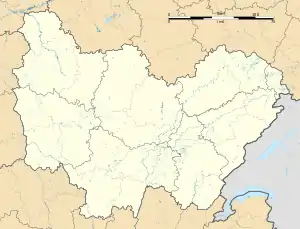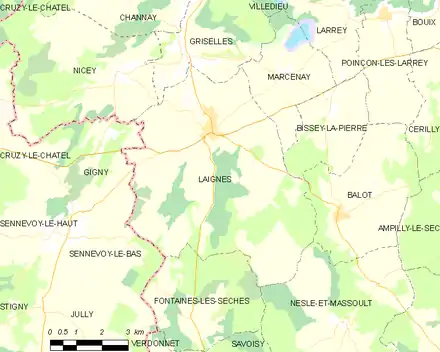Laignes
Laignes is a commune in the Côte-d'Or department, in the Bourgogne-Franche-Comté region in eastern France.
Laignes | |
|---|---|
 The town hall and resurgence of the Laigne River | |
.svg.png.webp) Coat of arms | |
Location of Laignes 
| |
 Laignes  Laignes | |
| Coordinates: 47°50′38″N 4°21′50″E | |
| Country | France |
| Region | Bourgogne-Franche-Comté |
| Department | Côte-d'Or |
| Arrondissement | Montbard |
| Canton | Châtillon-sur-Seine |
| Government | |
| • Mayor (2014–2020) | Jean-Michel Antoni |
| Area 1 | 40.02 km2 (15.45 sq mi) |
| Population (2017-01-01)[1] | 692 |
| • Density | 17/km2 (45/sq mi) |
| Time zone | UTC+01:00 (CET) |
| • Summer (DST) | UTC+02:00 (CEST) |
| INSEE/Postal code | 21336 /21330 |
| Elevation | 202–288 m (663–945 ft) (avg. 214 m or 702 ft) |
| 1 French Land Register data, which excludes lakes, ponds, glaciers > 1 km2 (0.386 sq mi or 247 acres) and river estuaries. | |
Geography

Laignes has a total area of 40 km2 and an approximate altitude of 220 m.
Near the town hall there is a basin formed by the resurgence of the Laigne River.
Accessibility
Laignes is traversed by RN 965 from Auxerre to Chaumont.
The nearest train stations are found at Nuits (17 kilometers) and Montbard (25 kilometers). There is a bus connection to Gare de Montbard, a (TGV) station.
Neighboring Communes
History
Prehistory and Antiquity
Refined flints and tombs dating to the Iron Age attest to the antiquity of the site’s occupation. The crossing of the roads from Auxerre to Langres and Alise to Vertault made it a very active place for the Lingones during the Gallo-Roman period: an ancient potter’s wheel was discovered near the train station bearing witness to the area’s artisanal past.
Middle Ages
Merovingian coins were struck at Laignes, especially those bearing the likeness of Charles the Bald. During this period, Laignes belonged to Tonnerre which passed from the Counts of Champagne to the Duchy of Burgundy. To resist various assaults from armed bands that ravaged the country during the Hundred Years' War, the city surrounded itself with fortifications; of which only a single round tower remains.
Modern Era
On the eve of the French Revolution, Laignes depended on goods from the Bailiwick of Sens in the County of Champagne and spiritual guidance from the Deanery of Châtillon-sur-Seine, part of the Diocese of Langres.[2]
Heraldry
.svg.png.webp) |
Blazon:
"Gules a Bend Or with Two Towers Argent"
Comments: Its official status is to be determined. |
List of Mayors
| Term | Name | Party | Description |
|---|---|---|---|
| 19th Century | M. Mauris | - | - |
| 1941-1947 | Gabriel Beau | - | - |
| 1947-1974 | Émile Lepître | Independent Republicans | - |
| 1974-1995 | Jean-Pierre Recq | UDF | - |
| 1995-2008 | Jean-Paul Noret | Socialist Party | - |
| 2008–Present | Jean-Michel Antoni | UMP | - |
| This list of mayors is incomplete. | |||
Demographics
The changes in the number of inhabitants are documented using census data collected since 1793. Starting in the first decade of the 21st century, the official population of every commune has been published annually. The census is now based on information collected annually, over a five-year period. For communes with fewer than 10,000 people, a census is taken every five years. The official population of the intervening years is determined by interpolation or extrapolation.[3] For this community, this procedure was originally used in 2005.[4]
In 2014, the commune had 747 inhabitants, a change of -8.12% from 2009 (Côte-d'Or: 1.36%; France excluding the Department of Moyotte: 2.49%).
Population change
| 1793 | 1800 | 1806 | 1821 | 1831 | 1836 | 1841 | 1846 | 1851 |
|---|---|---|---|---|---|---|---|---|
| 1593 | 1559 | 1768 | 1514 | 1476 | 1492 | 1563 | 1534 | 1547 |
| 1856 | 1861 | 1866 | 1872 | 1876 | 1881 | 1886 | 1891 | 1896 |
|---|---|---|---|---|---|---|---|---|
| 1421 | 1410 | 1391 | 1380 | 1340 | 1341 | 1289 | 1232 | 1158 |
| 1901 | 1906 | 1911 | 1921 | 1926 | 1931 | 1936 | 1946 | 1954 |
|---|---|---|---|---|---|---|---|---|
| 1149 | 1186 | 1138 | 1068 | 1072 | 1109 | 1051 | 1046 | 1047 |
| 1962 | 1968 | 1975 | 1982 | 1990 | 1999 | 2004 | 2009 | 2014 |
|---|---|---|---|---|---|---|---|---|
| 1032 | 1073 | 1004 | 1008 | 904 | 881 | 874 | 777 | 747 |
From 1962 to 1999: Population without double counting; For the dates afterword: municipal population.
(Sources: EHESS/Cassini up to 1999[5] then INSEE starting in 2006.[6]
Histogram of the population change

Monuments and Historic Places
 Église Saint-Didier was designated a monument historique (national heritage site) in 1930.[7] Its furniture and statuary date to the 16th and 17th centuries.[8]
Église Saint-Didier was designated a monument historique (national heritage site) in 1930.[7] Its furniture and statuary date to the 16th and 17th centuries.[8]- The sculpture at the resurgence of the Laignes River and the basin at the center of town.
 The former Café des Chiens Blancs (Cafe of the White Dogs), now a multimedia library on the main square near the town hall. It was designated a monument historique in 1995.[9]
The former Café des Chiens Blancs (Cafe of the White Dogs), now a multimedia library on the main square near the town hall. It was designated a monument historique in 1995.[9]- Old freight station on the line from Nuits-sous-Ravières to Châtillon-sur-Seine.
- Old medieval tower near the west entrance of the commune.
- The Chappelle Sainte-Marguerite (English: Chapel of Saint Margaret) on the road to Fontaines-les-Sèches.
- The elementary school.
 Café des Chiens Blancs.
Café des Chiens Blancs. The Laigne.
The Laigne. A street in the village.
A street in the village.
Notable Personalities
- André Metthey, (1871-1920), world-renowned ceramic artist, born 4 June 1871 in Laignes, and died in Asnières-sur-Seine in 1920.
- Christine Petit, born in Laignes in 1948, physician and researcher, professor at the Collège de France and the Pasteur Institute.
- Doctor Paul Robert was born on Réunion in 1904, physician in Laignes from 1930 to 1939, and killed by the Nazis on 11 June 1944 in Essarois.
- André Osterberger, (1920-2009), professional hammer thrower, born 26 Oct 1920 in Laignes. In 1950, he held the French record in the hammer throw with a mark 51.66 meters and had a mark of 52.95 meters in the 1952 Olympics.
See also
References
- "Populations légales 2017". INSEE. Retrieved 6 January 2020.
- (René Paris 1986, p. 96)
- "L'organisation du recensement (English: The organization of the census)"From the Insee site (French).
- "Calendrier départemental des recensements (English: Departmental Census Calendar)"From the Insee site (French).
- "Des villages de Cassini aux communes d'aujourd'hui (English: From the Villages of Cassini to the Communes of Today)"From l'École des hautes études en sciences sociales (French).
- INSEE census sheets for the following years (in French):
2006, 2007, 2008, 2009, 2010, 2011, 2012, 2013, 2014 - Base Mérimée
- (René Paris 1986, p. 97)
- "Café des Chiens Blancs", recensement immeubles MH (list of historical buildings), ref. PA00135222, Base Mérimée, Ministry of Culture.
Bibliography
- Le Canton de Laignes par les cartes postales, de Jean Millot et XX, mine d'informations sur Laignes et les environs.
- Le Dictionnaire de l'athlétisme par Robert Parienté, extrait in L’Équipe athlétisme magazine du 10 novembre 1971.
- René Paris (1986), "Aignay-le-Duc, Baigneux-les-Juifs, Laignes", À la rencontre du Châtillonnais, La Bourgogne
| Wikimedia Commons has media related to Laignes. |

